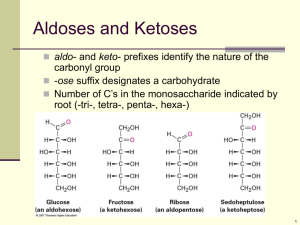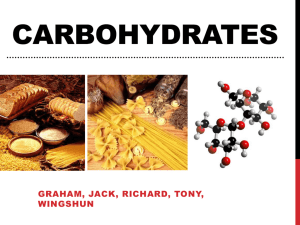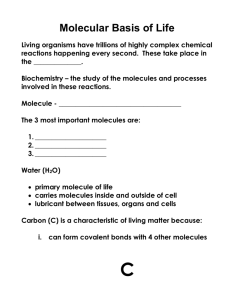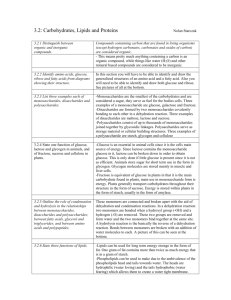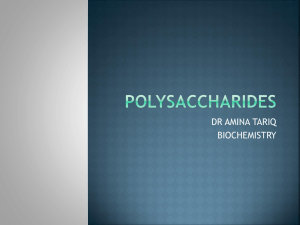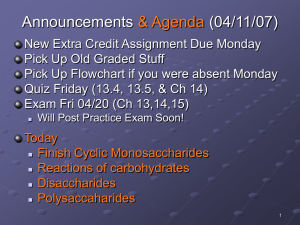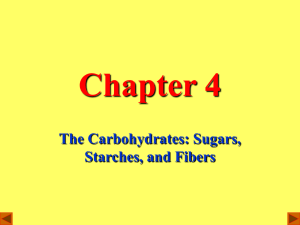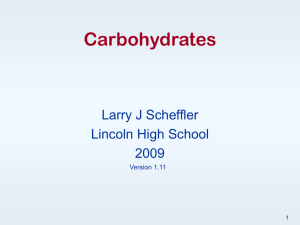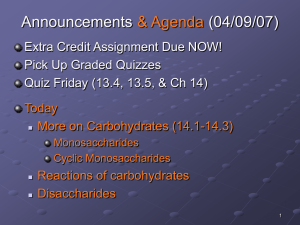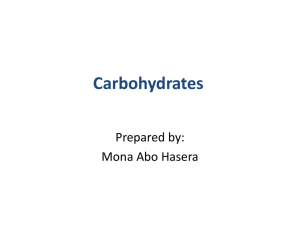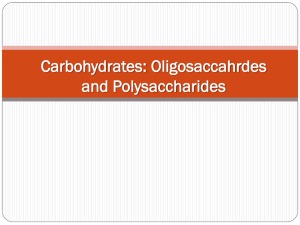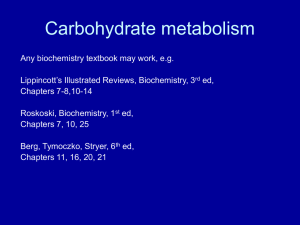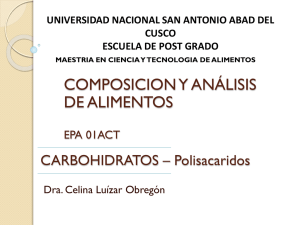212_carbohydrates 2008
advertisement
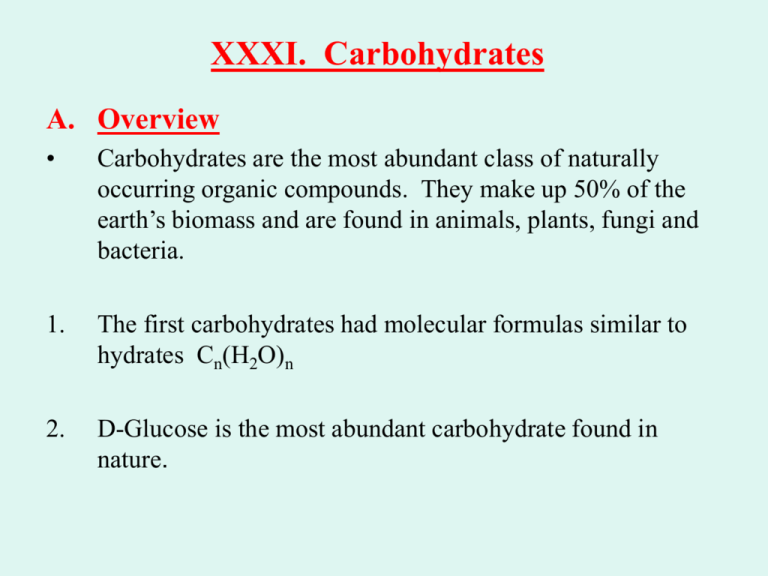
XXXI. Carbohydrates A. Overview • Carbohydrates are the most abundant class of naturally occurring organic compounds. They make up 50% of the earth’s biomass and are found in animals, plants, fungi and bacteria. 1. The first carbohydrates had molecular formulas similar to hydrates Cn(H2O)n 2. D-Glucose is the most abundant carbohydrate found in nature. 3. Biological Systems CO2 + H2O + Energy (Photosynthesis) Starch Glucose Animals Humans Glycogen Glucose Cellulose Plants H2O + CO2 + Energy B. Classification Carbohydrates Simple Monosaccharides (can not be hydrolyzed to simpler sugars) Complex Disaccharides Oligosaccharides Polysaccharides Starch Glycogen Cellulose Monosaccharides • Trioses (3-carbons) Glyceraldehyde • Tetroses (4-carbons) Erythrose, Threose • Pentoses (5-carbons) Pentose • Hexoses (6-carbons) Glucose, Mannose Galactose, Fructose C. D and L Configurations 1. Trioses D & L designations are based on the configuration about the single stereocenter in CHO H glyceraldehyde. C Right OH Left HO C H CH2OH CH2OH D-glyceraldehyde CHO L-glyceraldehyde (R)-2,3-Dihydroxypropanal CHO 2. Tetroses Erythrose and Threose H C OH CH2OH D-glyceraldehyde CHO HO C H CH2OH L-glyceraldehyde 3. Hexoses For sugars with more than one chiral center, D or L refers to the asymmetric C farthest from the aldehyde or keto group. Most naturally occurring sugars are D isomers. O H C H – C – OH HO – C – H H – C – OH H – C – OH CH2OH D-glucose D and L sugars are enantiomers of one another. O H C HO – C – H H – C – OH HO – C – H HO – C – H CH2OH L-glucose The D Aldose Family => D. Epimers Carbohydrates that differ in configuration at only one carbon center. Not Epimers => E. Cyclic Hemiacetals of Monosacchaarides 1. Cyclic Hemiacetal - Mechanism 2. Glucose 3. Anomers • Carbohydrates that differ in configuration only at their anomeric carbon. • An anomeric carbon is a hemiacetal or acetal carbon in a carbohydrate. E. Cyclic Hemiacetals of Monosacchaarides 1. Cyclic Hemiacetal - Mechanism 2. Glucose 4. Chair β-D-Glucopyranose α-D-Glucopyranose β-D-Glucose α-D-Glucose 5. Cyclic Structure for Fructose β-D-Fructofuranose F. Mutarotation 1. When anomers dissolved in water undergo a slow change in optical rotation to an equilibrium value, this process is called mutrotation. 2. Only sugars with hemiacetal anomeric carbons can undergo mutarotation. 3. Sugars which undergo mutarotation are called reducing sugars. 4. Mutarotation of Glucose 36% α-D-Glucopyranose 0.2% 64% β-D-Glucopyranose H. Disaccharides • A Disaccharide on hydrolysis is cleaved to two monosaccharides. • The monosaccharides are linked as a glycoside (acetal). 1. Cellobiose • Two glucose units linked β-1-4’. • Disaccharide of cellulose. • A mutarotating, reducing sugar. 2. Maltose • Two glucose units linked α-1-4’. • Disaccharide of starch • A mutarotating, reducing sugar => 3. Lactose • Galactose + glucose linked β-1-4’. • “Milk sugar”, reducing sugar => 4. Sucrose • Glucose + fructose, linked α,β-1,1’(2’) • Nonreducing sugar, no mutrotation = I. Polysaccharides • Polysaccharides have more than ten monosaccharides units joined by a glycosidic linkage. 1. Starch Amylose (20%) H2O Soluble Amylopectin (80%) H2O Insoluble 2. Amylose • Soluble starch, polymer of D-glucose. • Starch-iodide complex, deep blue. => Helical Structure of Amylose 3. Amylopectin • Branched, insoluble fraction of starch, α-1-4’, α-1-6’ every 20-30 glucose units. => 4. Cellulose • Polymer of β-D-glucose, found in plants. • Mammals lack the -glycosidase enzyme. • Rigid linear structure. => 5. Glycogen • Glucose polymer, α-1-4’, α-1-6’ every 10 glucose units. • Similar to amylopectin, but even more highly branched. • Energy storage in muscle tissue and liver. • The many branched ends provide a quick means of putting glucose into the blood. • => CH2OH CH2OH O H H OH H H OH H O OH CH2OH H H OH H H OH H H OH CH2OH O H OH O H OH H H O O H OH H H OH H H O 4 glycogen H 1 O 6 CH2 5 H OH 3 H CH2OH O H 2 OH H H 1 O CH2OH O H 4 OH H H H H O OH O H OH H H OH H OH Glycogen, the glucose storage polymer in animals, is similar in structure to amylopectin. But glycogen has more a(16) branches. The highly branched structure permits rapid release of glucose from glycogen stores, e.g., in muscle during exercise. The ability to rapidly mobilize glucose is more essential to animals than to plants. Gentiobiose • Two glucose units linked 1-6’. • Rare for disaccharides, but commonly seen as branch point in carbohydrates. =

